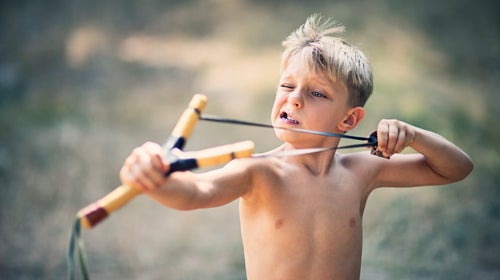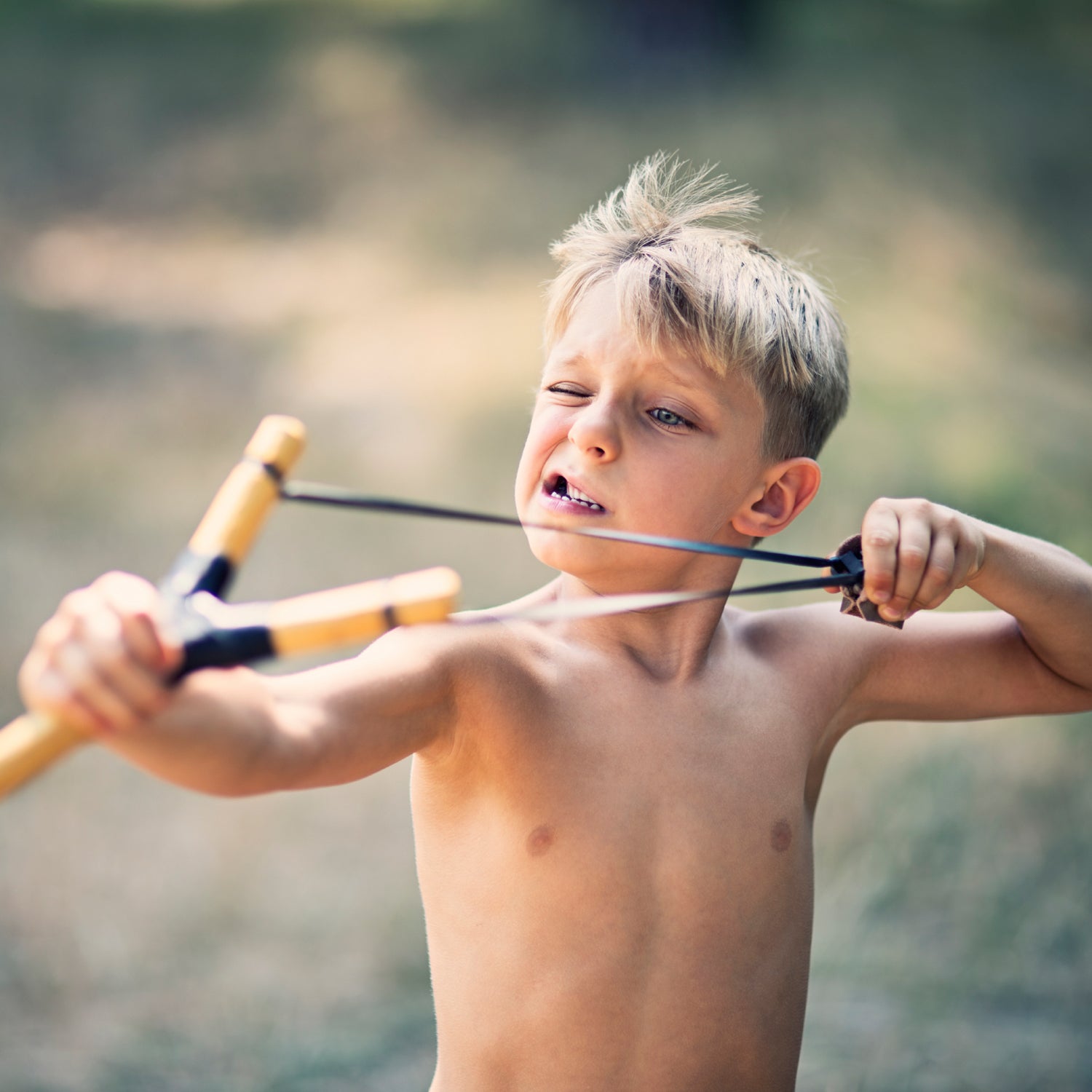The other morning after breakfast, my five-year-old daughter whined, “I’m bored!” Few words have the power to rankle parents more than these two (except maybe “When are we gonna be there?”). It was Saturday and the whole day stretched luxuriously before us. We didn’t have to hustle off to school or pack lunches or fly off in four different directions. We could simply hang around and do nothing.
Therein lay the problem.
I told my daughter what my mother had told me when I was a girl: that being bored meant I just hadn’t thought of something clever to do. Boredom reflected poorly on me, not my circumstances. Then I shooed her and her seven-year-old sister out to the arroyo to play.
The arroyo is a dry, sandy wash that runs a few hundred feet below our house. We’ve found piles of rusty tin cans there, traces of a makeshift homeless camp (long abandoned), and other random cast-offs. Mostly, though, it’s wild little corridor between steep hillsides, lined with piñon and juniper trees and bound by sandy cliffs that are perfect for scooting down on your bottom—a narrow slice of nature a few blocks from downtown Santa Fe.
For the past few months, the girls have been earning their independence in the arroyo. At nearly six and eight, they are old enough to venture into it on their own—as long as they follow a few basic rules. They must always stick together, bring the dog, keep the house more or less within sight, come when I call, and carry a walkie-talkie in case they run into trouble.
That morning I watched them wander down the trail, dragging our dog, Pete, on a leash. Every five or ten minutes (though it might have been closer to two), I walked outside and cocked an ear. I couldn’t see them in the arroyo, but I’d be able to hear them if they yelled, and I knew Pete would bark if a stranger approached. After a few minutes, my little one raced up the trail, red-faced and sweaty. “I need a jar!” she exclaimed, running past me into the house. A minute later, she came out clutching a mason jar and two magnets she’d swiped from the fridge. “We’re collecting iron,” she explained, pronouncing it i-Ron. Then she was gone again. I was dying to follow her, but I knew if I did, I’d defeat the whole purpose: inventing their own games and schemes, without me.
Child development experts call these kinds of spontaneous, child-directed activities “free play.” A generation ago, when kids were far more likely to wander out the door and goof off in the yard or ride bikes with their friends, this didn’t need special terminology. It was just called play. A seminal 1997 study from the University of Michigan determined that the amount of spare time kids in the U.S. had to play dropped by 25 percent since 1981, and Boston University psychologist Peter Gray has found that it has been declining ever since. In a , the found that “much of parent-child time is spent arranging special activities or transporting children between those activities… Many parents seem to feel as though they are running on a treadmill to keep up yet dare not slow their pace for fear their children will fall behind.”
“There’s Mandarin on Monday, piano on Tuesday, soccer on Wednesday,” says Lenore Skenazy, founder of the movement. “It’s all part of the race to the top.” And it’s not just children of privilege who lead more structured lives. Often underserved kids or those whose parents work full time go straight from class to school-subsidized aftercare.
Then there’s the innate parental fear that unsupervised kids will fall prey to shady characters. (The statistics don’t bear this out, however: crime against children since the early 1990s. Finally, a rash of recent high-profile incidents in Maryland and South Carolina, in which parents were questioned by the police for sending their children into public without supervision, have sent the message that it’s negligent to let kids roam free. “An unsupervised childhood has become taboo,” says Skenazy.
In moderation, organized extracurricular activities instill skills and competence in kids, boost their confidence, and give parents both time to work (I’m writing this while my seven-year-old is at mountain-biking club) and peace of mind that their children are being looked after. “No one wants their kids to be unsafe,” says Skenazy.
But child-directed play is essential to children’s emotional and intellectual development. According to the American Academy of Pediatrics 2007 report, “some play must remain entirely child driven, with parents either not present or as passive observers, because play builds some of the individual assets children need to develop and remain resilient.”
A from University of Colorado found that children between six and seven who engaged in less-structured activities like imaginative role-playing, reading for pleasure, and playing board games and tag demonstrated greater so-called “executive function,” or the ability to organize their time, initiate tasks, and achieve goals without external direction—skills which help build self-reliance and success later in life (and ensure that they’re not still living at home when they’re 30).
“These were any kind of activities where adults were not present to organize the way the activity unfolded,” explains the study’s lead author, Jane Barker, who notes that the results held for controls like family income and gender. “We saw the same the benefits of free play in boys and girls, and families with greater or less means.”
Still, not all free play is quite so free. For single parents and dual-working parents, setting aside blocks of time for unsupervised fun can be challenging. “I put my daughter in activities when she was young because it gave me bigger blocks of time to work than when she was home playing. I would take her to gymnastics and sit in the stands and pull out my computer,” says Carol Greenhouse, a single mother whose daughter is now 13.
Where you live may pose obstacles, too. While rural families may have open space right out the front door, they may not have a built-in posse of neighbor kids nearby. Urbanites may lack nature but have a larger local community of like-minded families. Ultimately, says Skenazy, “the only people who have the luxury not to let their kids out for free play are those who live in truly violent neighborhoods.”
Indoors or outside, alone or with other kids, the important thing is that children are left to their own devices to invent, organize and enjoy their own schemes and dreams. “You can have free play in your room, but there are more loose parts to play with outside in nature,” says Richard Louv, who wrote the bestselling book Last Child in the Woods and his latest, Vitamin N, in an effort to combat what he coined “nature-deficit disorder.” Louv is talking about the Theory of Loose Parts, devised in the early 1970s by an architect who found that the more variables in an environment—the more things people can manipulate, see, touch or feel—the more creative they are.
Here’s how to set your child loose:
Build a Community
Don’t just assume your friends feel the same about free play as you do. When Greenhouse, who lives in rural Vermont, learned that neighboring parents didn’t let their 13-year-old daughter and her daughter explore the stream on their property without adult supervision, she was surprised. “We live in a sweet liberal town; everyone believes in kids going outside, but is it really happening? This family is full of big kayakers. I didn’t think I’d have to talk to them about this, but I guess I do.” Open the lines of communication with other parents about your shared goals for getting kids together for unstructured play and together strategize ways to make it a reality.
Schedule Unscheduled Play
It sounds counterintuitive, but in this hyper-organized world, being intention is essential. Skenazy recommends creating a Free-Range Kids Club through your child’s school or in your neighborhood, as a group of parents in the Chicago suburbs recently did. Block off one day a week so that a critical mass of kids have free time after school. It can happen anywhere—at the park, downtown, walking home from school. The only organized part is the day of the week. “It’s like wildflowers–if you want to bring them back, sometimes you actually have to take the seeds and plant them. If something has been destroyed that was natural and occurred spontaneously, it sometimes requires help and planning to bring back. Once you have a bunch of kids together, without an adult to ask what to do, everything kicks in: problem solving, empathy, creativity, imagination.”
Strive for Balance
No one’s saying you should wipe your youngster’s weekly calendar clean of karate, Spanish club, or swim team. Just find pockets here and there to let him be a kid on his own terms. How much free play do they need? While Barker and her team of researchers don’t recommend a specific amount of time, Louv favors the same guidelines he offers to combat nature-deficit-disorder: “Some is better than none and more is better than some.”
Become a Hummingbird Parent
If your child is too young to play unsupervised, train yourself to be a hummingbird, not a helicopter—one who hovers at a distance. “Watch kids from kitchen window, or let them explore the periphery of the park on their own,” says Louv. “Swoop in only if your child is in mortal danger. That’s a technique you can learn.”
Encourage Aimlessness and Even Adversity
Not every minute needs to fulfill some obvious purpose in your child’s life. “Even time that seems fallow or ‘unenriched” is very enriching,” says Skenazy. “If you just watch the birds every day, you’d learn a lot about birds, or if you are bored watching birds, you’d go do something else, like read or paint.” Adversity, too, isn’t something to be feared, either. “Many people say, ‘I can’t let my kids go out because something bad may happen,’ says Skenazy. “But it’s important to remember that not all bad things are tragedies. Often when adults are asked think back on something in their childhood that they felt proud of, usually it’s when something did go wrong and they had to muddle through.”
Engage Them Afterwards
After your child finishes playing, ask them to tell you about their adventures. Showing interest sends the message that their independence is valued and matters. When my five-year-old Maisy came home toting two jars filled with fine, black shavings, I asked to shown me how she’d collected it. “Here,” she said, pouring some iron in the dirt and handing me a magnet. When I skimmed the shavings with the magnet, the iron clumped onto it like a fuzzy coating of fur. I sat on the ground next to her, doing it over and over, feeling like a kid again.


